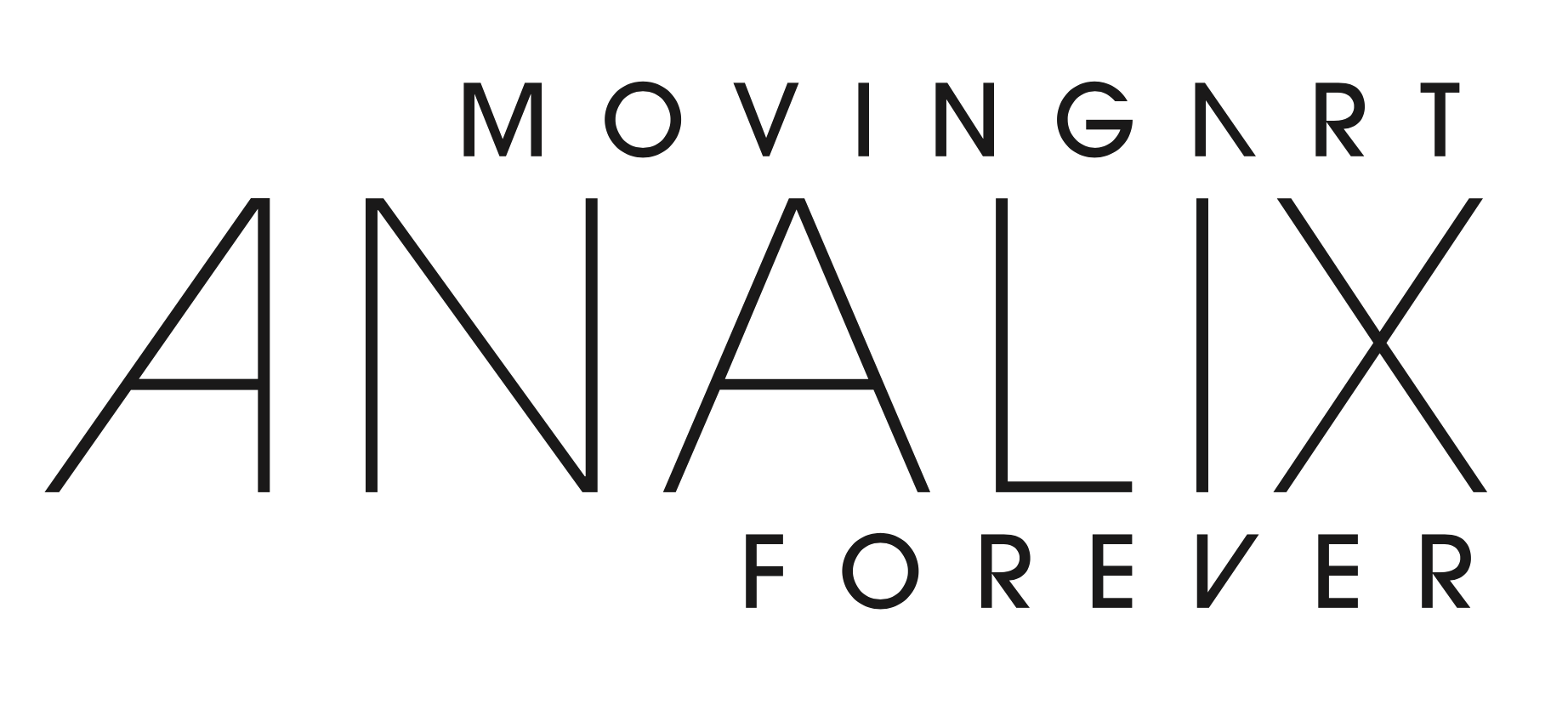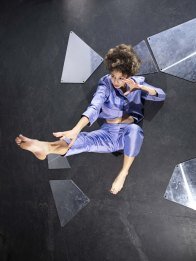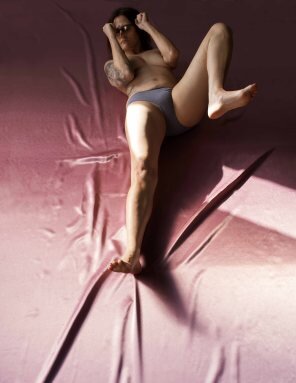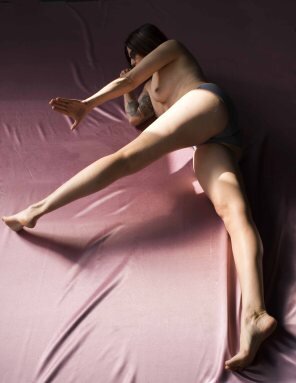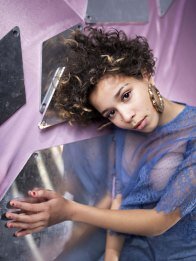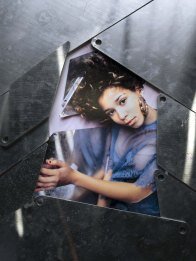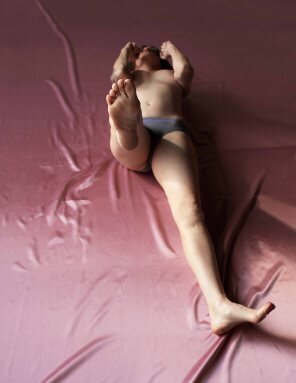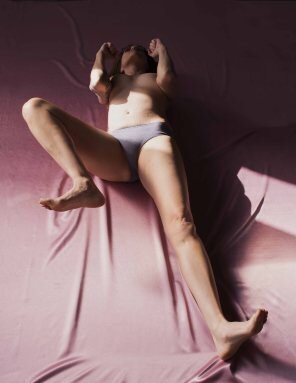Le corps confiné, le corps libéré par Dana Hoey
Dana Hoey : La liberté du regard
Dana Hoey réclame pour elle-même et pour ses modèles, pour toutes les femmes, la liberté de montrer et de se montrer, ou non, d’être regardée, admirée, désirée, ou non, de photographier et d’être photographiée, ou non, et d’être protégée. La liberté d’exister et d’être aussi bien classiquement « féminine » que classiquement « masculine », l’un et/ou l’autre, ou non. Le regard que Dana Hoey porte sur les femmes est à la fois frontal et oblique, ludique et inquiet, et nous révèle, avec une grande tendresse et autant de puissance que de mélancolie, de peur que de force, de volonté que d’effroi, notre place et notre position au monde, telle qu’elle est et telle que la liberté la voudrait.
À propos de la série Eleanor, Dana Hoey explique : « Eleanor est une jeune danseuse que j’ai d’abord rencontrée dans le cadre de cours de boxe thaï, et qui m’a frappée par la grâce de ses coups de pied, par sa beauté aussi. C’est cette combinaison qui m’a amenée à lui demander de poser. Je voulais m’éloigner d’une esthétique de la combattante masculinisée et me rapprocher d’une beauté plus délicate – beauté qu’Eleanor incarne. Elle m’a parlé, alors, de ce que signifiait pour elle être une jeune femme, quand tout le monde vous regarde et attend quelque chose de vous. Je ne reproche à personne de regarder, je l’ai fait moi-même et Eleanor est époustouflante. Mais sur les photos, j’ai voulu l’entourer d’éclats de métal dur et scintillant en formes de diamant pour représenter à la fois le désir d’être jolie et celui de résister au regard et de repousser les indésirables. Eleanor flotte avec force et élégance dans un espace intemporel : celui d’être – et d’être vue. »
L’intérêt que Dana Hoey porte depuis toujours aux situations étranges, voire absconses, est au mieux représenté par Boardroom, image iconique de l’ « uncanniness » et de l’humour singulier de l’artiste, que l’on retrouve dans nombre de ses travaux (voir dossier joint ci-dessous). Comme l’écrivait à son propos Jean-Paul Gavard Perret : « Dana Hoey réenchante le monde, le sort de sa glaciation masculine, dans un érotisme qui tient moins des premiers émois que d’un espace mental. La suggestion reste le maître mot d’un travail attentif à la volupté et à une paradoxale précision, et si l’image devient mémoire, il ne s’agit pas de celle du temps passé mais d’un incessant avenir : l’incessant avenir de la féminité. »
Il est une autre photographie de Dana Hoey, Faye Silver, qui appelle à être regardée, scrutée, pendant des heures, tant elle recèle de l’âme et du regard hypersensible que la photographe porte sur le monde (voir dossier joint ci-dessous). On y voit une petite fille avec des gants de boxe et un casque. La photographie est prise en négatif. La position de la tête et le regard de la petite fille sont empreints d’une volonté de fer. Mais peu à peu on découvre autre chose, et la raison de l’utilisation du négatif : les poignets de la petite fille sont si minces, disproportionnés par rapport à la tête et, en réalité, elle est assise. Pourquoi une boxeuse serait-elle assise, si ce n’est que ses jambes ne peuvent la porter. Et la photographie, progressivement, révèle que la petite fille souffre d’une myopathie. À l’impossibilité de sortir de son corps, Faye Silver oppose l’espace mental. Un espace qui revendique la poignante liberté d’être : d’être forte en dépit de sa fragilité, mieux encore, avec elle, et de se voir puissante envers et contre tout. Un espace mental qui revendique la discordance, les renversements de rôles, une autre vision du monde. Et l’on comprend que l’utilisation du négatif était ici indispensable, lui qui apporte à l’image une forme de légèreté bienvenue pour contenir la profondeur du propos.
Dana Hoey, philosophe photographe, nous apprend à regarder l’image à côté de l’image, derrière l’image. Femme volontariste, artiste hypersensible, Dana Hoey se laisse émerveiller par la beauté et l’étrangeté du monde. Et partage avec nous la liberté de son regard. Notamment sur elle-même, en plein entrainement de boxe thaï. « Je suis à un âge fertile pour l’autoportrait, dit l’artiste : je ne suis ni jeune ni vielle, ni à l’âge classique de la consommation d’image, et pourtant je me vois forte et belle. Les mouvements que je photographie sont pratiqués dans le vide, ce qui leur donne une vibration antigravitationnelle qui m’intéresse. »
Une liberté de mouvement, d’âge et de gravité.
Dana Hoey: Freedom of gaze
Dana Hoey claims for herself and for her models, for all women, the freedom to show others and oneself, or not, to be watched, admired, desired, or not, to photograph and to be photographed, or no, and to be protected; the freedom to exist and to be what is consider classically “feminine” and classically “masculine”, both, or none. Dana Hoey’s gaze on women is both frontal and oblique, playful and anxious, and reveals to us with great tenderness and as much power as melancholy, fear as strength, will as dread, our place and our position in the world, as it is and as freedom would like it.
About the series Eleanor, Dana Hoey explains: “Eleanor is a young dancer whom I first met during Thai boxing lessons. And I was struck by the grace of her kicks, as well as her beauty. This combination is what initially led me to ask her to shoot. I wanted to depart from a masculinized fighter aesthetic and approach a more delicate beauty, which she embodies. She talked to me, then, about what it means to be a young woman, when everyone looks at you and wants something from you. I don’t blame anyone for looking, I did it myself and Eleanor is stunning. But in the photos, I wanted to surround her with shards of hard and glittery metal in diamond shapes to give her a space where she could both express the desire to be pretty and resist the gaze, and fend unwanted pursuers off. Eleanor floats strongly and elegantly in a timeless space: a space of being, and being seen.”
The interest that Dana Hoey has always demonstrated for strange, sometimes even abstruse, situations is best represented by Boardroom, an iconic image of “uncanniness” and the peculiar sense of humor of the artist, which is found in many of her works (see document bellow). As Jean-Paul Gavard Perret wrote: “Dana Hoey re-enchants the world, far for the fate of male glacial era, in an eroticism that belongs more to a deep mental space than to initial emotional moments. Suggestion remains the watchword of Hoey’s work, a body of work paradoxically caring as much for precision as for pleasure,. Here, when the image becomes memory, it is not a memory of the past, but of an endless future: the future of femininity.”
There is another photograph by Dana Hoey, Faye Silver, which calls for hours of gaze and scrutiny, as it contains much of the hypersensitive soul of the photographer and of her way to look at and depict the worlds (see document bellow). We see a girl with boxing gloves and a helmet. The photograph is taken in negative. The position of the head and the gaze of the girl are marked with an iron will. But little by little we discover something else, and the reason for using the negative: the girl’s wrists are so thin, disproportionate to the head and, in reality, she is sitting on a chair. Why would a boxer be seated, except that her legs cannot carry her. And the photograph gradually reveals that the girl is suffering myopathy. To the impossibility to get out of her body, Faye Silver opposes a mental space. A space that claims the poignant freedom to be: to be strong in spite of her fragility, better still, with it, and to present herself as powerful against all odds. This mental space claims discordance, role reversals, a different vision of the world. And we understand that the use of the negative was essential here, as it brings to the image a form of lightness that contributes to the better containment of the depth of the subject.
Dana Hoey, a philosopher and a photographer, teaches us to look at the image next to the image, behind the image. Both a self-asserted woman and a hypersensitive artist, Dana Hoey allows herself to be taken by the beauty and the strangeness of the world and shares with us the freedom of her gaze. Particularly on herself, in the practice of Thai boxing training. “I am at a fertile age for self-portrait” says the artist. “I am neither young nor old, nor in the conventional age for photographic consumption yet I think I look pretty strong and great. The movements of Muay Thai are done in the air, which gives them an eerie vibration of not just shadow-boxing but anti-gravity.”
A freedom of movement, age and gravity.
